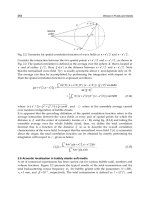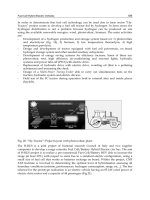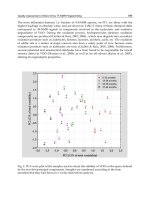Access: Acid-Base, Fluids, and Electrolytes - part 7 potx
Bạn đang xem bản rút gọn của tài liệu. Xem và tải ngay bản đầy đủ của tài liệu tại đây (410.04 KB, 50 trang )
METABOLIC ALKALOSIS 285
TREATMENT
TABLE 7–18: Treatment
Treatment of metabolic alkalosis, as with all acid-base
disturbances, hinges on correction of the underlying
disease state
The severity of the acid-base disturbance itself may be life
threatening in some cases, and require specific therapy; this
is especially true in mixed acid-base disturbances where pH
changes are in the same direction (such as a respiratory
alkalosis from sepsis and a metabolic alkalosis secondary
to vomiting)
Emergent control of systemic pH
In the setting of a clinical emergency, controlled
hypoventilation must be employed
In this clinical condition, intubation, sedation, and controlled
hypoventilation with a mechanical ventilator (sometimes
using inspired CO
2
and/or supplemental oxygen to prevent
hypoxia) is often lifesaving
Urgent control of systemic pH
Once the situation is no longer critical, partial or complete
correction of metabolic alkalosis over the ensuing 6–8 h
with HCl administered as a 0.15-M solution through a central
vein is preferred; arginine hydrochloride can also be used
The effect of HCl is not rapid enough to prevent or treat
life-threatening complications
(continued)
286 METABOLIC ALKALOSIS
TABLE 7–18 (Continued)
Generally, the “acid deficit” is calculated assuming a
bicarbonate distribution space of 0.5 times body weight in
liters, and about half of this amount of HCl is given with
frequent monitoring of blood gases and electrolytes
These agents can result in significant potential complications;
hydrochloric acid may cause intravascular hemolysis and
tissue necrosis, while ammonium chloride may result in
ammonia toxicity
Noncritical situations
In less urgent settings, metabolic alkalosis is treated after
examining whether it is Cl
−
-responsive or not
Cl
−
-responsive metabolic alkalosis is responsive to volume
repletion; coexistent hypokalemia should also be corrected
Cl
−
-resistant metabolic alkaloses are treated by antagonizing
the mineralocorticoid (or mineralocorticoid-like substance)
that maintains renal H
+
losses; this sometimes can be
accomplished with spironolactone, eplerenone, or other
distal K
+
-sparing diuretics like amiloride
It is not unusual that the cause of metabolic alkalosis is
due to a therapy that is essential in the management of
a disease state
• The proximal tubule diuretic acetazolamide, which
decreases the PT for HCO
3
–
by inhibiting proximal tubule
HCO
3
–
reabsorption, may need to be added to the diuretic
regimen of patient’s with severe edema forming states
• Prescription of a proton pump inhibitor will decrease
gastric H
+
losses in the patient who requires prolonged
gastric drainage
Abbreviation: PT, plasma threshold
287
8
Respiratory and Mixed
Acid-Base Disturbances
OUTLINE
Respiratory Disturbances 289
8–1. Introduction 289
Figure 8–1. A Simplified Schematic of Elements 289
8–2. Chemoreceptors and the Control of Automatic 290
Breathing
8–3. The Physical Machinery of Breathing 291
Respiratory Acidosis 292
8–4. Causes of Respiratory Acidosis 292
8–5. Compensation for Respiratory Acidosis 294
Respiratory Alkalosis 296
8–6. Causes of Respiratory Alkalosis 296
8–7. Compensation for Respiratory Alkakosis 298
Mixed Disturbances 300
8–8. The Diagnosis of Mixed Disturbances— 300
Degree of Compensation
8–9. The Diagnosis of Mixed Disturbances— 302
The Search for Hidden Disorders
Copyright © 2007 by The McGraw-Hill Companies, Inc.
Click here for terms of use.
288 RESPIRATORY AND MIXED ACID-BASE DISTURBANCES
Figure 8–2. Use of the Anion Gap in Evaluation 303
Figure 8–3. Acid-Base Nomogram 304
8–10. Syndromes Commonly Associated with Mixed 305
Acid-Base Disorders
8–11. The Importance of the Diagnosis of Mixed 306
Acid-Base Disorders
RESPIRATORY AND MIXED ACID-BASE DISTURBANCES 289
RESPIRATORY DISTURBANCES
TABLE 8–1: Introduction
Definitions
Breathing—an automatic, rhythmic, and centrally regulated
process by which contraction of the diaphragm and rib cage
moves gas in and out of airways and alveolae of the lung
Respiration—includes breathing, but also involves the
circulation of blood, allowing for O
2
intake and CO
2
excretion
Control of breathing
Automatic
• Largely under the control of PCO
2
• Control center resides in the brainstem within the reticular
activating system (medullary respiratory areas and pontine
respiratory group)
Volitional—less is known about this control mechanism
FIGURE 8–1: A Simplified Schematic of Elements Involved
in Controlling Ventilation
290 RESPIRATORY AND MIXED ACID-BASE DISTURBANCES
TABLE 8–2: Chemoreceptors and the Control
of Automatic Breathing
The two systems (central and peripheral) interact, with
hypoxia the central response to PCO
2
is enhanced
Central
Located in the medulla of the CNS
Responds to changes in PaCO
2
largely through changes in
brain pH (interstitial and cytosolic)
A sensitive system, PaCO
2
control is generally tight
Respiratory control by oxygen tensions is much less
important until PaO
2
falls to levels below 70 mmHg; this
is a reflection of the Hb-O
2
dissociation curve since Hb
saturation is generally above 94% until PaO
2
falls below
70 mmHg
Peripheral
Located in the carotid bodies although less important
receptors were identified in the aortic arch
O
2
control of respiration is mediated largely through
peripheral chemoreceptors which, in response to low PaO
2
,
close ATP-sensitive K
+
channels and depolarize glomus
cells in the carotid body
With chronic hypercapnia, control of respiration by CO
2
is
severely blunted leaving some patients’ respiration almost
entirely under the control of O
2
tensions
Abbreviations: CNS, central nervous system; ATP, adenosine
triphosphate
RESPIRATORY AND MIXED ACID-BASE DISTURBANCES 291
TABLE 8–3: The Physical Machinery of Breathing
Involves both the lungs, as well as bones and thoracic
musculature that interact to move air in and out of the
pulmonary air spaces
Abnormalities of either the skeleton, musculature, or
airways, air spaces, and lung blood supply may impair
respiration
The physical machinery of breathing can be assessed by PFTs
PFTs readily differentiate problems with airway resistance
(e.g., asthma or COPD) from those of alveolar diffusion
(e.g., interstitial fibrosis) or neuromuscular function (e.g.,
phrenic nerve palsy, Guillian-Barré syndrome)
Pulmonary ventilation—the amount of gas brought into
and/or out of the lung
Expressed as minute ventilation (i.e., how much air is
inspired and expired within 1 min) or in functional terms as
alveolar ventilation since the portion of ventilation
confined to conductance airways does not effectively
exchange O
2
for CO
2
in alveolae
We can reference ventilation with regard to either O
2
or
CO
2
, however, since CO
2
excretion is so effective and
ambient CO
2
tensions in the atmosphere are low,
pulmonary ventilation generally is synonymous with
pulmonary CO
2
excretion
CO
2
is much more soluble than O
2
and exchange across the
alveolar capillary for CO
2
is essentially complete under
most circumstances, whereas some O
2
gradient from
alveolus to the alveolar capillary is always present
Abbreviations: PFT, pulmonary function test; COPD, chronic
obstructive pulmonary disease
292 RESPIRATORY AND MIXED ACID-BASE DISTURBANCES
RESPIRATORY ACIDOSIS
Defined as a primary increase in PaCO
2
secondary to decreased
effective ventilation with net CO
2
retention.
This decrease in effective ventilation can occur from defects
in any aspect of ventilation control or implementation.
TABLE 8–4: Causes of Respiratory Acidosis
Acute
Airway obstruction—aspiration of foreign body or vomitus,
laryngospasm, generalized bronchospasm, obstructive
sleep apnea
Respiratory center depression—general anesthesia, sedative
overdosage, cerebral trauma or infarction, central sleep
apnea
Circulatory catastrophes—cardiac arrest, severe pulmonary
edema
Neuromuscular defects—high cervical cordotomy,
botulism, tetanus, Guillain-Barré syndrome, crisis in
myasthenia gravis, familial hypokalemic periodic
paralysis, hypokalemic myopathy, toxic drug agents
(e.g., curare, succinylcholine, aminoglycosides,
organophosphates)
Restrictive defects—pneumothorax, hemothorax, flail chest,
severe pneumonitis, hyaline membrane disease, adult
respiratory distress syndrome
Pulmonary disorders—pneumonia, massive pulmonary
embolism, pulmonary edema
Mechanical underventilation
RESPIRATORY AND MIXED ACID-BASE DISTURBANCES 293
TABLE 8–4 (Continued)
Chronic
Airway obstruction—chronic obstructive lung disease
(bronchitis, emphysema)
Respiratory center depression—chronic sedative depression,
primary alveolar hypoventilation, obesity hypoventilation
syndrome, brain tumor, bulbar poliomyelitis
Neuromuscular defects—poliomyelitis, multiple sclerosis,
muscular dystrophy, amyotrophic lateral sclerosis,
diaphragmatic paralysis, myxedema, myopathic disease
(e.g., polymyositis, acid maltase deficiency)
Restrictive defects—kyphoscoliosis, spinal arthritis,
fibrothorax, hydrothorax, interstitial fibrosis, decreased
diaphragmatic movement (e.g., ascites), prolonged
pneumonitis, obesity
294 RESPIRATORY AND MIXED ACID-BASE DISTURBANCES
TABLE 8–5: Compensation for Respiratory Acidosis
Compensation for respiratory acidosis occurs at several
levels; some of these processes are rapid, whereas others
are slower; this latter fact allows us to distinguish between
acute and chronic respiratory acidosis in some cases
With respiratory acidosis, a rise in [HCO
3
–
] is a normal,
compensatory response
As is the case for metabolic disorders, a failure of this normal
adaptive response is indicative of the presence of metabolic
acidosis in the setting of a complex or mixed acid-base
disturbance
Conversely, an exaggerated increase in HCO
3
–
producing a
normal pH indicates the presence of metabolic alkalosis in
the setting of a complex or mixed acid-base disturbance
Mechanisms
Acute
Increases in PaCO
2
and decreases in O
2
tension stimulate
ventilatory drive
Increases in PaCO
2
are immediately accompanied by a shift
to the right of the reaction shown below in Eq. (8-1)
resulting in an increase in HCO
3
–
concentration
[HCO
3
–
] in mEq/L increases by 0.1 times the increase in
PaCO
2
in mmHg (±2 mEq/L)
Chronic
The kidney provides the mechanism for the majority of
chronic compensation
RESPIRATORY AND MIXED ACID-BASE DISTURBANCES 295
TABLE 8–5 (Continued)
As PaCO
2
increases and arterial pH decreases, renal acid
excretion and bicarbonate retention become more avid;
some of this is a direct chemical consequence of elevated
PaCO
2
and mass action facilitating intracellular
bicarbonate formation, whereas other portions involve
genomic adaptations of tubular cells involved in renal
acid excretion
Enzymes involved in renal ammoniagenesis (e.g., glutamine
synthetase), as well as apical and basolateral ion transport
proteins (e.g., Na
+
-H
+
exchanger, Na
+
-K
+
ATPase) are
synthesized in increased amounts at key sites within the
nephron
Chronic respiratory acidosis present for at least 4–5 days is
accompanied by a [HCO
3
–
] increase = 0.4 times the
increase in PaCO
2
(mmHg) (±3 mEq/L)
Renal correction never completely returns arterial pH to the
level it was at prior to CO
2
retention
H
2
CO
3
→ H
؊
+ HCO
3
؊
(8-1)
Abbreviation: ATP, adenosine triphosphate
296 RESPIRATORY AND MIXED ACID-BASE DISTURBANCES
RESPIRATORY ALKALOSIS
Respiratory alkalosis is defined as a primary decrease in PaCO
2
secondary to an increase in effective ventilation with net CO
2
removal. This increase in effective ventilation can occur from
defects in any aspect of ventilation control or implementation.
TABLE 8–6: Causes of Respiratory Alkalosis
Hypoxia
Decreased inspired oxygen tension
Ventilation-perfusion inequality
Hypotension
Severe anemia
CNS mediated
Voluntary hyperventilation
Neurologic disease: cerebrovascular accident (infarction;
hemorrhage); infection (encephalitis, meningitis); trauma;
tumor
Pharmacologic and hormonal stimulation—salicylates,
ditrophenol, nicotine, xanthines, pressor hormones,
pregnancy
Pulmonary disease
Interstitial lung disease
Pneumonia
Pulmonary embolism
RESPIRATORY AND MIXED ACID-BASE DISTURBANCES 297
TABLE 8–6 (Continued)
Pulmonary edema
Mechanical overventilation
Miscellaneous
Hepatic failure
Gram-negative septicemia
Anxiety-hyperventilation syndrome
Heat exposure
Abbreviation: CNS, central nervous system
298 RESPIRATORY AND MIXED ACID-BASE DISTURBANCES
TABLE 8–7: Compensation for Respiratory Alkakosis
The normal compensatory response is a fall in [HCO
3
–
]
Failure of this normal adaptive response is indicative of the
presence of metabolic alkalosis in the setting of a complex
or mixed acid-base disturbance
An exaggerated decrease in [HCO
3
–
] producing a normal pH
indicates the presence of metabolic acidosis in the setting of
a complex or mixed acid-base disturbance
Mechanisms
• Acute
Decreases in PaCO
2
will inhibit ventilatory drive, in some
way antagonizing the process that led to reductions in CO
2
tension
Decreases in PaCO
2
are immediately accompanied by a shift
to the left of the reaction shown in Eq. (8-1)
and decreases in [HCO
3
–
] result
The decrease in [HCO
3
–
] (in mEq/L) is 0.1 times the
decrease in PaCO
2
in mmHg (with an error range of ±2
mEq/L)
• Chronic
The kidney provides the mechanism for the majority of
chronic compensation
As PaCO
2
decreases and arterial pH increases, renal
excretion of acid and retention of bicarbonate are reduced
RESPIRATORY AND MIXED ACID-BASE DISTURBANCES 299
TABLE 8–7 (Continued)
Chronic respiratory alkalosis present for at least 4–5 days
will be accompanied by a [HCO
3
–
] decrease (in mEq/L) of
0.4 times the increase in PaCO
2
(mmHg) (with an error
range of ±3 mEq/L)
Renal correction never completely returns arterial pH to the
level it was at prior to respiratory alkalosis
Decreases in [HCO
3
–
] below 12 mEq/L are generally not
seen from metabolic compensation for respiratory alkalosis
300 RESPIRATORY AND MIXED ACID-BASE DISTURBANCES
MIXED DISTURBANCES
TABLE 8–8: The Diagnosis of Mixed Disturbances—
Degree of Compensation
One first evaluates the degree of compensation
Inadequate compensation is equivalent to another primary
acid-base disturbance
It is important to recognize that compensation is never
complete; compensatory processes cannot return one’s
blood pH to what it was before one suffered a primary
disturbance
The first clue to the presence of a mixed acid-base disorder
is the degree of compensation, “over compensation” or an
absence of compensation are certain indicators that a mixed
acid-base disorder is present
For metabolic disorders, respiratory compensation should be
immediate; it is relatively easy to determine whether
compensation is appropriate using the rules of
compensation below
Rules of compensation-metabolic disturbances
• Metabolic acidosis: compensatory change in PaCO
2
(mmHg) = 1–1.5 × the fall in [HCO
3
–
] (mEq/L) or the
PaCO
2
(mmHg) = 1.5 × [HCO
3
–
] + 8 ± 2
• Metabolic alkalosis: compensatory change in PaCO
2
(mmHg) = 0.6 – 1 × the increase in [HCO
3
–
] (mEq/L)
RESPIRATORY AND MIXED ACID-BASE DISTURBANCES 301
TABLE 8–8 (Continued)
For respiratory disorders metabolic compensation takes days
to become complete; mass action will produce about a
0.1 mEq/L change in [HCO
3
–
] for every 1 mmHg change in
PaCO
2
; a complete absence of metabolic compensation for
respiratory acidosis or alkalosis clearly indicates a second
primary disturbance; for degrees of compensation between
0.1 and 0.4 mEq/L/mmHg change in PaCO
2
, it is difficult
if not impossible to distinguish between a failure of
compensation (e.g., a primary metabolic disorder) and an
acute respiratory disturbance on the blood gas alone
Rules of compensation-respiratory disturbances
• Acute respiratory acidosis or alkalosis: compensatory
change in [HCO
3
–
] (mEq/L) = 0.1 × the change in PaCO
2
(mmHg) ± 2 (mEq/L)
• Chronic respiratory acidosis or alkalosis: compensatory
change in [HCO
3
–
] (mEq/L) = 0.4 × the change in PaCO
2
(mmHg) ± 3 (mEq/L)
302 RESPIRATORY AND MIXED ACID-BASE DISTURBANCES
TABLE 8–9: The Diagnosis of Mixed Disturbances—
the Search for Hidden Disorders
One next evaluates the anion gap (Eq. 8-2)
Calculating the SAG provides insight into the differential
diagnosis of metabolic acidosis (anion gap and nonanion
gap metabolic acidosis) and can also indicate that metabolic
acidosis is present in the patient with an associated
metabolic alkalosis
Compare the change in SAG to the change in serum
bicarbonate concentration; if the change in the SAG is much
larger than the fall in serum bicarbonate concentration, one
can infer the presence of both an anion gap metabolic
acidosis and metabolic alkalosis
If the fall in serum bicarbonate concentration is; however,
much larger than the increase in the SAG (and the SAG is
significantly increased) one can infer the presence of both
an anion gap and nonanion gap metabolic acidosis
SAG = [Na
+
] − [Cl
–
] − [HCO
3
–
] (8-2)
Formula for the serum anion gap (SAG)
Abbreviation: SAG, serum anion gap
RESPIRATORY AND MIXED ACID-BASE DISTURBANCES 303
FIGURE 8–2: Use of the Anion Gap in Evaluation of Mixed
Acid-Base Disturbances. To use the SAG in the approach to a
complex acid-base disorder, we make the stoichiometric
assumption that for a pure organic acidosis
⌬SAG =
⌬[HCO
3
؊
]. Since we don’t have “pre” and “post” disorder
values, we further assume that SAG started at 10 mEq/L and
[HCO
3
؊
] started at 24 mEq/L. With these assumptions, we can
diagnose simultaneous anion gap metabolic acidosis and
metabolic alkalosis when the SAG Is large and the
decrease in [HCO
3
؊
] Is relatively small. Conversely, we can
Also diagnose simultaneous nonanion gap metabolic
acidosis with anion gap metabolic acidosis if the fall in
[HCO
3
؊
] Is much larger than the modestly but significantly
increased SAG
304 RESPIRATORY AND MIXED ACID-BASE DISTURBANCES
FIGURE 8–3: Acid-Base Nomogram. A second approach
to the evaluation of mixed acid-base disturbances
involves the use of a nomogram rather than using
the rules of compensation and the interpretation
of the serum anion gap
RESPIRATORY AND MIXED ACID-BASE DISTURBANCES 305
TABLE 8–10: Syndromes Commonly Associated with Mixed
Acid-Base Disorders
Hemodynamic compromise
Cardiopulmonary arrest
Pulmonary edema
Sepsis
Liver failure
Poisonings
Ethylene glycol intoxication
Methanol intoxication
Aspirin intoxication
Ethanol intoxication
Metabolic disturbances
Severe hypokalemia
Severe hypophosphatemia
Diabetic ketoacidosis
Bowel ischemia
COPD
Chronic kidney disease
Abbreviation: COPD, chronic obstructive pulmonary disease
306 RESPIRATORY AND MIXED ACID-BASE DISTURBANCES
TABLE 8–11: The Importance of the Diagnosis of Mixed
Acid-Base Disorders
Helps one gain insight into the clinical problems the patient
is facing
Confers appropriate urgency to the clinical situation
Prompts a search for potential causes of additional acid-base
disturbance(s)
Treatment of the acid-base disorder always involves making
the correct clinical diagnosis of the underlying causes and
appropriate specific therapy directed at those causes
307
9
Disorders of Serum Calcium
OUTLINE
Regulation 310
9–1. Regulation of ECF Ionized Calcium 310
9–2. Calcium Fluxes between ECF and 311
Organ Systems
Figure 9–1. Total Body Calcium Homeostasis 311
9–3. The Calcium-Sensing Receptor 312
Figure 9–2. Relationship between PTH Released 314
by Parathyroid Gland and ECF Ionized
Ca
2+
Concentration
9–4. PTH Mechanisms of Action 315
Figure 9–3. The Calcitriol Biosynthetic Pathway 316
9–5. Calcitriol 317
9–6. Renal Calcium Excretion 318
Hypercalcemia 320
9–7. Etiologies of Hypercalcemia 320
9–8. Hypercalcemia—Increased GI Ca
2+
321
Absorption
9–9. Hypercalcemia—Increased Bone Ca
2+
323
Resorption (Hyperparathyroidism—Primary)
Copyright © 2007 by The McGraw-Hill Companies, Inc.
Click here for terms of use.
308 DISORDERS OF SERUM CALCIUM
9–10. Hypercalcemia—Increased Bone Ca
2+
324
Resorption (Hyperparathyroidism—Secondary)
9–11. Hypercalcemia—Increased Bone Ca
2+
325
Resorption (Hyperparathyroidism—MEN
Syndromes)
9–12. Hypercalcemia—Increased Bone Ca
2+
326
Resorption (Malignancy— PTHrP Related)
9–13. Hypercalcemia—Increased Bone Ca
2+
327
Resorption (Malignancy—Other Causes)
9–14. Hypercalcemia—FHH 329
9–15. Hypercalcemia—Other Causes 331
9–16. Signs and Symptoms 332
9–17. Diagnosis 333
9–18. Diagnosis (Clinical Laboratory) 334
9–19. Treatment (Medical—General Principles) 336
9–20. Treatment (Medical—Blocking 338
Bone Resorption-I)
9–21. Treatment (Medical—Blocking
Bone Resorption-II) 340
9–22. Treatment (Medical—Reducing Intestinal 341
Absorption)
9–23. Treatment (Surgical) 342
9–24. Minimally Invasive Parathyroid Surgery 344
Hypocalcemia 345
9–25. Pathophysiologic Mechanisms 345
9–26. Etiologies of Hypocalcemia 346
DISORDERS OF SERUM CALCIUM 309
9–27. Hypocalcemia—Secondary to Disorders 348
of Decreased PTH Synthesis or Release—
Hypomagnesemia
9–28. Hypocalcemia—Secondary to Disorders 349
of Decreased PTH Synthesis or Release—
Other Causes
9–29. Hypocalcemia—Secondary to Disorders 351
of End-Organ Resistance to PTH
9–30. Hypocalcemia—Disorders Secondary to 352
Defects in Vitamin D Metabolism
9–31. Hypocalcemia—Other Causes 354
9–32. Signs and Symptoms 356
Figure 9–4. An Algorithm for the Differential 357
Diagnosis of Hypocalcemia
9–33. Approach to the Patient with a Low Total 358
Serum Ca
2+
Concentration
9–34. Treatment—Inpatients 360
9–35. Oral Ca
2+
Preparations 361
9–36. Oral Vitamin D Preparations 362
9–37. Treatment—Outpatients 363









